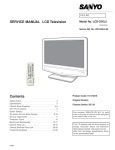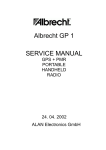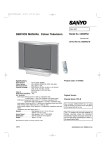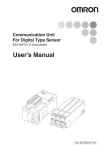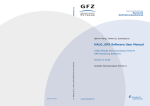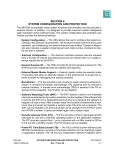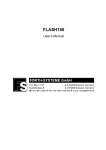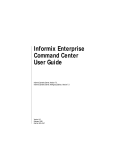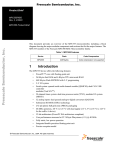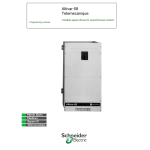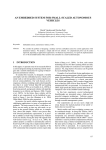Download Hardware Manual - Phytec Messtechnik GmbH
Transcript
phyCORE-MPC555 Hardware Manual Edition July 2005 A product of a PHYTEC Technology Holding company phyCORE-MPC555 In this manual are descriptions for copyrighted products that are not explicitly indicated as such. The absence of the trademark () and copyright () symbols does not imply that a product is not protected. Additionally, registered patents and trademarks are similarly not expressly indicated in this manual. The information in this document has been carefully checked and is believed to be entirely reliable. However, PHYTEC Meßtechnik GmbH assumes no responsibility for any inaccuracies. PHYTEC Meßtechnik GmbH neither gives any guarantee nor accepts any liability whatsoever for consequential damages resulting from the use of this manual or its associated product. PHYTEC Meßtechnik GmbH reserves the right to alter the information contained herein without prior notification and accepts no responsibility for any damages which might result. Additionally, PHYTEC Meßtechnik GmbH offers no guarantee nor accepts any liability for damages arising from the improper usage or improper installation of the hardware or software. PHYTEC Meßtechnik GmbH further reserves the right to alter the layout and/or design of the hardware without prior notification and accepts no liability for doing so. Copyright 2005 PHYTEC Meßtechnik GmbH, D-55129 Mainz. Rights - including those of translation, reprint, broadcast, photomechanical or similar reproduction and storage or processing in computer systems, in whole or in part - are reserved. No reproduction may occur without the express written consent from PHYTEC Meßtechnik GmbH. Address: EUROPE NORTH AMERICA PHYTEC Technologie Holding AG Robert-Koch-Str. 39 D-55129 Mainz GERMANY PHYTEC America LLC 203 Parfitt Way SW, Suite G100 Bainbridge Island, WA 98110 USA Ordering +49 (800) 0749832 Information: [email protected] 1 (800) 278-9913 [email protected] Technical Support: +49 (6131) 9221-31 [email protected] 1 (800) 278-9913 [email protected] Fax: +49 (6131) 9221-33 1 (206) 780-9135 Web Site: http://www.phytec.de http://www.phytec.com 5th Edition: July 2005 PHYTEC Meßtechnik GmbH 2005 L-523e_5 Contents Preface ...........................................................................................................1 1 Introduction .........................................................................................1 1.1 Block Diagram..............................................................................4 1.2 View of the phyCORE-MPC555..................................................5 2 Pin Description ....................................................................................7 3 Jumpers ..............................................................................................19 4 5 Power System and Reset Behavior ..................................................25 Start-up System Configuration ........................................................27 5.1 Power-On Reset Phase................................................................27 5.2 Hard Reset Configuration Word.................................................28 6 System Memory .................................................................................29 6.1 Memory Model after Reset.........................................................29 6.2 Runtime Memory Model ............................................................31 6.3 Flash Memory.............................................................................32 6.3.1 Internal Flash Memory of the MPC555 ........................32 6.3.2 External Flash Memory (U2, U3).................................32 6.4 Synchronous BURST-SRAM (U4 – U7) ..................................33 6.5 Serial Memory (U8)...................................................................34 7 Serial Interfaces .................................................................................37 7.1 RS-232 Interface.........................................................................37 7.2 CAN Interface.............................................................................38 7.3 BDM-Debug Interface ................................................................39 8 Real-Time Clock RTC-8564 (U10)...................................................41 9 Technical Specifications....................................................................43 10 Hints for Handling the Module ........................................................46 11 Revision History ................................................................................47 Appendices A ..............................................................................................49 A.1 Release Notes..............................................................................49 Index ............................................................................................................51 PHYTEC Meßtechnik GmbH 2005 L-523e_5 phyCORE-MPC555 Index of Figures and Tables Figure 1: Block Diagram phyCORE-MPC555 ............................................ 4 Figure 2: View of the phyCORE-MPC555.................................................. 5 Figure 3: Pinout of the phyCORE-MPC555 (Bottom View) ...................... 7 Figure 4: Numbering of the Jumper Pads .................................................. 19 Figure 5: Location of the Jumpers (Controller Side) and Default Setting (Standard Version of the phyCORE-MPC555) .................................................................. 19 Figure 6: Location of the Jumpers (Connector Side) and Default Setting (Standard Version of the phyCORE-MPC555) .................................................................. 20 Figure 7: Power Concept ........................................................................... 25 Figure 8: Default Memory Model after Hardware Reset........................... 29 Figure 9: I2C Slave Address of the Serial Memory (U8)........................... 35 Figure 10: 10-pin BDM Connector and Corresponding Pins of the phyCORE-Connector ................................................................. 40 Figure 11: Physical Dimensions .................................................................. 43 Table 1: Pinout of the phyCORE-Connector X1...................................... 18 Table 2: Jumper Settings .......................................................................... 24 Table 3: Clock Mode Configuration via Jumpers J2, J3 and J4............... 27 Table 4: Runtime Memory Map ............................................................... 31 Table 5: Flash Memory Device and Manufacturers Overview ................ 32 Table 6: Memory Options for the Synchronous BURST-SRAM ............ 33 Table 7: Memory Options for the Serial Memory U8.............................. 34 Table 8: I2C Address of the Serial Memory ............................................. 35 Table 9: Technical Data............................................................................ 44 PHYTEC Meßtechnik GmbH 2005 L-523e_5 Preface Preface This phyCORE-MPC555 Hardware Manual describes the module’s design and functions. Precise specifications for the Motorola MPC555 microcontroller series can be found in the enclosed MPC555 microcontroller Data-Sheet/User’s Manual. If software is included please also refer to additional documentation for this software. In this hardware manual and in the attached schematics, low active signals are denoted by a "/" in front of the signal name (i.e.: /RD). A "0" indicates a logic-zero or low-level signal, while a "1" represents a logic-one or high-level signal. The MSB and LSB of the data and address busses shown in the circuit diagram are based on the conventions of Motorola. Accordingly, D31 and A31 represent the LSB, while D0 and A0 represent the MSB. These conventions are also valid for the parallel I/O signals. Declaration regarding Electro Magnetic Conformity of the PHYTEC phyCORE-MPC555 PHYTEC Single Board Computers (henceforth products) are designed for installation in electrical appliances or as dedicated Evaluation Boards (i.e.: for use as a test and prototype platform for hardware/software development) in laboratory environments. Note: PHYTEC products lacking protective enclosures are subject to damage by ESD and, hence, may only be unpacked, handled or operated in environments in which sufficient precautionary measures have been taken in respect to ESD dangers. It is also necessary that only appropriately trained personnel (such as electricians, technicians and engineers) handle and/or operate these products. Moreover, PHYTEC products should not be operated without protection circuitry if connections to the product’s pin header rows are longer than 3 m. PHYTEC Meßtechnik GmbH 2005 L-523e_5 phyCORE-MPC555 PHYTEC products fulfill the norms of the European Union’s Directive for Electro Magnetic Conformity only in accordance to the descriptions and rules of usage indicated in this hardware manual (particularly in respect to the pin header rows or connectors, power connector and serial interface to a host-PC). Implementation of PHYTEC products into target devices, as well as user modifications and extensions of PHYTEC products, is subject to renewed establishment of conformity to, and certification of, Electro Magnetic Directives. Users should ensure conformance following any modifications to the products as well as implementation of the products into target systems. The phyCORE-MPC555 is one of a series of PHYTEC Single Board Computers that can be populated with different controllers and, hence, offers various functions and configurations. PHYTEC supports common 8-, 16- and selected 32-bit controllers on two types of Single Boards Computers: (1) as the basis for Rapid Development Kits which serve as a reference and evaluation platform (2) as insert-ready, fully functional micro-, mini- and phyCORE OEM modules, which can be embedded directly into the user’s peripheral hardware, design. PHYTEC’s microcontroller modules allow engineers to shorten development horizons, reduce design costs and speed project concepts from design to market. PHYTEC Meßtechnik GmbH 2005 L-523e_5 Introduction 1 Introduction The phyCORE-MPC555 belongs to PHYTEC’s phyCORE Single Board Computer module family. The phyCORE SBCs represent the continuous development of PHYTEC Single Board Computer technology. Like its mini-, micro- and nanoMODUL predecessors, the phyCORE boards integrate all core elements of a microcontroller system on a sub-miniature board and are designed in a manner that ensures their easy expansion and embedding in peripheral hardware developments. As independent research indicates that approximately 70 % of all EMI (Electro Magnetic Interference) problems stem from insufficient supply voltage grounding of electronic components in high frequency environments the phyCORE board design features an increased pin package. The increased pin package allows dedication of approximately 20 % of all pin header connectors on the phyCORE boards to Ground. This improves EMI and EMC characteristics and makes it easier to design complex applications meeting EMI and EMC guidelines using phyCORE boards even in high noise environments. phyCORE boards achieve their small size through modern SMD technology and multi-layer design. In accordance with the complexity of the module, 0402-packaged SMD and laser-drilled Microvias components are used on the boards, providing phyCORE users with access to this cutting edge miniaturization technology for integration into their own design. The phyCORE-MPC555 is a subminiature (72 x 57 mm) insert-ready Single Board Computer populated with Motorola’s PowerPC MPC555 microcontroller. Its universal design enables its insertion in a wide range of embedded applications. All controller signals and ports extend from the controller to high-density (0,635 mm) Molex pin header connectors aligning two sides of the board, allowing it to be plugged like a "big chip" into a target application. PHYTEC Meßtechnik GmbH 2005 L-523e_5 1 phyCORE-MPC555 Precise specifications for the controller populating the board can be found in the applicable controller User’s Manual or Data Sheet. The descriptions in this manual are based on the MPC555 controller. No description of compatible microcontroller derivative functions is included, as such functions are not relevant for the basic functioning of the phyCORE-MPC555. The phyCORE-MPC555 offers the following features: • Single Board Computer in subminiature form factor (72 x 57 mm) according to phyCORE specifications • All applicable controller and other logic signals extend to two high-density 160-pin Molex connectors • Processor: Motorola embedded PowerPC MPC555 (40 MHz clock) • Internal Features of the MPC555: - 2 32-bit PowerPC core, 40MHz CPU speed 64-bit Floating Point Unit 26 kByte SRAM; capable of battery buffering 448 kByte FLASH Dual UART/SPI Dual CAN 2.0B Dual TPU with 16 channels each Two 16-bit timer system Eight channel 16-bit PWM system Dual 10-bit ADC (7µs) with 32(41) channels (ext. MUX) Multi-Purpose I/O signal JTAG/BDM test/debug port PHYTEC Meßtechnik GmbH 2005 L-523e_5 Introduction • Memory Configuration1: - SRAM: • • • • • • 1: 128 kByte to 8 MB flow-through Synchronous Burst-RAM, 32-bit access, 0 wait states, 2-1-1-1 Burst mode - Flash-ROM: 0 / 512 kBytes/ 1 MB/ 2 MB/ 4 MB, 32-bit width 2 - I C Memory: 4 kByte EEPROM (up to 32 kByte, alternatively I2C FRAM, I2C SRAM) I2C Real-Time Clock with calendar and alarm function Power-down/wake-up support via RTC, decrementor, or external signal Dual UART/SPI port: RS-232 transceiver for both channels (RxD/TxD); also configurable as TTL Dual CAN port: CAN transceiver 82C251 for both channels; also configurable as TTL JTAG/BDM test/debug port Available in standard (0…+70°C) and industrial (-40…+85°C) temperature ranges Please contact PHYTEC for more information about additional module configurations. PHYTEC Meßtechnik GmbH 2005 L-523e_5 3 phyCORE-MPC555 1.1 Block Diagram 40 MHz CPU-Clock PLL MPC555 32-Bit PowerPC Core 64-Bit FPU 448kB FLASH-Eprom 64-Bit Timebase 32-Bit Decrementer 20 MHz Quarz 128kB to 8MB Sync. BurstSRAM 32-Bit, 0 Wait I2C-Memory FRAM or EEPROM or SRAM UART/QSPI A RS232 Transceiver UART/QSPI B RS232 Transceiver CAN A CAN Transceiver CAN B CAN Transceiver VDDH/VDDL VPD 26kB SRAM MIOS Counter/PWM/IO Figure 1: 4 TPU A TPU B ADC A ADC B 0 to 8MB FLASHEPROM 32-Bit I2C-RTC Clock Calendar Alarm p h y C O R E C o n n e c t o r Data-Bus Address-Bus Control-Signals /IRQRTC I2C-Bus /IRQ[0..4] RXD1, TXD1 RXD1, TXD1, QSPI RXD2, TXD2 RXD2, TXD2, QSPI A_CANL, A_CANH A_CANRX, A_CANTX B_CANL, B_CANH B_CANRX, B_CANTX /WakeUp +3.3V +5V VBat JTAG/BDM MDA[0..9], MPWM[0..7] MPIO[0..15] A_TPU[0..15], B_TPU[0..15] A_T2CLK, B_T2CLK A_AD[0..15], B_AD[0..15] ETRIG[1,2] Block Diagram phyCORE-MPC555 PHYTEC Meßtechnik GmbH 2005 L-523e_5 R34 R35 R36 Figure 2: CB3 R11 L1 R31 R32 R30 R4 PHYTEC Meßtechnik GmbH 2005 C28 CB43 L-523e_5 X1 R12 U9 R39 R38 R8 R16 C5 CB6 CB33 X1 D C J21 J20 1169.5 CB34 C1 C2 C10 J1 T1 Q1 R9 CB32 R26 D2 C21 C14 J12 J6 J11 U12 U11 J7 CB10 C4 U13 J14 J13 CB15 CB42 CB25 CB24 CB38 C22 C8 Xt1 CB18 C30 U3 T2 R28 R29 J8 CB21 CB39 CB41 CB25 CB20 1169.5 C20 U14 C16 R3 C7 C19 R40 R43 R44 U15 L4 L6 L7 L5 U10 C27 R15 CB31 R14 RN16 J19 U8 CB23 J10 CB37 CB19 U7 CB27 R42 R47 R46 C26 C25 C23 C24 J17 CB8 R41 R48 R45 CB44 C13 RN15 CB13 J16 B28 C17 U16 R23 R27 U2 CB14 C3 C12 CB35 U4 R37 R33 U17 R49 CB45 L3 L2 C11 RN11 RN19 U5 CB29 R7 RN18 RN12 J18 R6 RN9 RN8 RN10 RN17 RN7 RN21 RN20 RN14 RN13 CB4 CB2 CB30 C18 CB5 R20 R19 R18 R17 R22 RN6 RN3 R10 R5 R2 CB1 R21 C15 RN5 RN2 J5 CB11 J15 J4 J3 J2 CB16 CB40 CB22 CB36 C29 C6 D1 RN4 RN1 Introduction 1.2 View of the phyCORE-MPC555 R24 C9 R1 J9 U1 U6 CB17 CB9 D3 R13 CB12 R25 CB7 A B View of the phyCORE-MPC555 5 phyCORE-MPC555 6 PHYTEC Meßtechnik GmbH 2005 L-523e_5 Pin Description 2 Pin Description Please note that all module connections are not to exceed their expressed maximum voltage or current. Maximum signal input values are indicated in the corresponding controller manuals/data sheets. As damage from improper connections varies according to use and application, it is the user’s responsibility to take appropriate safety measures to ensure that the module connections are protected from overloading through connected peripherals. As Figure 3 indicates, all controller signals extend to high density 0,635 mm SMT-plugs (refered to as phyCORE-Connector) lining two sides of the board (refer to section 9). This allows the phyCORE-MPC555 to be plugged into any target application like a "big chip". Many of the controller port pins accessible at the edges of the board have been assigned alternate functions that can be activated via software. Table 1 provides an overview of the pinout of the phyCOREConnector. Please refer to the Motorola MPC555 User Manual/Data Sheet for details on the functions and features of controller signals and port pins. / D C B A 1 1 80 80 X1 Figure 3: 1 1 80 80 X1 Pinout of the phyCORE-MPC555 (Bottom View) PHYTEC Meßtechnik GmbH 2005 L-523e_5 7 phyCORE-MPC555 Pin Number Pin row X1A 1A 2A, 7A, 12A, 17A, 22A, 27A, 32A, 37A, 42A, 47A, 52A, 57A, 62A, 67A, 72A, 77A 3A Connection I/O Comments EXTCLK GND I - Optional external clock input of the MPC555 Ground 0 V /IRQ3 I 4A /IRQ0 I 5A 6A /CS2 /CS1 O O 8A /WE3 O /IRQ3 interrupt of the MPC555. Alternative: /KR, /RETRY, SGPIOC3 (I/O) /IRQ0 interrupt of the MPC555. Alternative: SGPIOC0 (I/O) Free /CS signal of the MPC555. /CS signal of processor for control of synchronous SRAM U4-U7. Write enable signal for the data lines D[24..31]. Note that D31 represents the LSB Alternative: AT3 (O) The alternative function may only be used if no on-board memory is populated. Address lines1 Alternative: SGPIOA30, SGPIOA29, SGPIOA27, SGPIOA24, SGPIOA22, SGPIOA21, SGPIOA19, SGPIOA16, SGPIOA14, SGPIOA13, SGPIOA11, SGPIOA8 (I/O) For the use of the alternative function, note that the address lines are partially used for memory addressing. Data lines1 Alternative: SGPIOD30, SGPIOD29, SGPIOD27, SGPIOD24, SGPIOD22, SGPIOD21, SGPIOD19, SGPIOD16, SGPIOD14, SGPIOD12, SGPIOD11, SGPIOD9, SGPIOD6, SGPIOD4, SGPIOD3, SGPIOD1 (I/O) For use of the alternative function, note that the data lines are used to connect the onboard memory devices. Transfer acknowledge signal of the MPC555. Transfer error acknowledge signal of the MPC555. Bus busy signal of the MPC555. Alternative: VF2 (O), IWP3 (O) Transfer size signal of the MPC555. 9A, 10A, 11A, A30, A29, A27, 13A, 14A, 15A, A24, A22, A21, 16A, 18A, 24A, A19, A16, A14, 25A, 26A, 28A A13, A11, A8 I/O 19A, 20A, 21A, D30, D29, D27, 23A, 29A, 30A, D24, D22, D21, 31A, 33A, 38A, D19, D16, D14, 39A, 40A, 41A, D12, D11, D9, 43A, 44A, 45A, D6, D4, D3, 46A D1 I/O 8 34A /TA I/O 35A /TEA I/O 36A /BB I/O 51A TSIZ0 I/O PHYTEC Meßtechnik GmbH 2005 L-523e_5 Pin Description Pin Number 48A, 49A, 50A Connection NC 53A 54A 55A 56A 58A /TS RDNWR /BDIP /BURST /BI//STS 60A 61A 63A 64A 65A 66A 68A 69A 70A 71A 73A 74A 75A 76A 78A 79A 80A B_TPU15, B_TPU13, B_TPU11, B_TPU9, B_TPU7, B_TPU5, B_TPU3, B_TPU1 B_T2CLK A_TPU15, A_TPU13, A_TPU11, A_TPU9, A_TPU7, A_TPU5, A_TPU3, A_TPU1 Pin row X1B 1B 2B CLKOUT /IRQ1 O I 3B /IRQ2 I 4B, 9B, 14B, 19B, 24B, 29B, 34B, 39B, 44B, 49B, 54B, 59B, 64B, 69B, 74B, 79B GND PHYTEC Meßtechnik GmbH 2005 I/O Comments - Not connected These contacts should remain unconnected on the target hardware side. I/O Transfer start signal of the MPC555. I/O Read/write (RD//WR) signal of the MPC555. I/O Burst data in progress signal of the MPC555. I/O Burst indicator signal of the MPC555. I/O Burst inhibit signal of the MPC555. Alternative: special transfer start (O) I/O TPU I/O signals connected to the TPU B of the MPC555. I/O Clock signal of the TPU B of the MPC555. I/O TPU I/O signals connected to the TPU A of the MPC555. Processor clock of the MPC555 /IRQ1 interrupt request of the MPC555 Alternative: /RSV (O), SGPIOC1 (I/O) /IRQ2 interrupt request of the MPC555 Alternative: /CR (I), SGPIOC2 (I/O), /MTS (O) Per default, following a system reset, the /MTS function is pre-selected. The function can be configured in the register SIUMCR (Bits MTSC, MLRC). Ground 0 V L-523e_5 9 phyCORE-MPC555 Pin Number 5B 6B Connection /CS3 /CS0 7B 8B, 10B, 11B, 12B, 13B, 15B, 16B, 17B, 23B, 25B, 26B, 27B /OE A31. A28, A26, A25, A23, A20, A18, A17, A15, A12, A10, A9 18B, 20B, 21B, 22B, 28B, 30B, 31B, 32B, 37B, 38B, 40B, 41B, 42B, 43B, 45B, 46B D31, D28, D26, D25, D23, D20, D18, D17, D15, D13, D10, D8, D7, D5, D2, D0 33B /WE2 35B /BG 36B /BR 47B, 48B, 50B NC 51B 52B TSIZ1 /WE1 53B /WE0 10 I/O Comments O Free /CS signal of the MPC555 O /CS signal1 of the MPC555 used as control of the on-board Flash memory O Output enable1 signal of the MPC555 I/O Address lines1: A31 is the LSB! Alternative: SGPIOA31, SGPIOA28, SGPIOA26, SGPIOA25, SGPIOA23, SGPIOA20, SGPIOA18, SGPIOA17, SGPIOA15, SGPIOA12, SGPIOA10, SGPIOA9 (I/O) For use of the alternative function, note that the address lines are partially used for memory addressing. I/O Data lines1: D31 is the LSB and D0 is the MSB! Alternative: SGPIOD31, SGPIOD28, SGPIOD26, SGPIOD25, SGPIOD23, SGPIOD20, SGPIOD18, SGPIOD17, SGPIOD15, SGPIOD13, SGPIOD10, SGPIOD8, SGPIOD7, SGPIOD5, SGPIOD2, SGPIOD0 (I/O) For use of the alternative function, note that the address lines are partially used for memory addressing. O Write enable signal1 for data lines D[16..23] Alternative: AT2 (O) The alternative function can only be used when no on-board memory is populated. I/O Bus grant signal of the MPC555 Alternative: VF0 (O), LWP1 (O) I/O Bus request signal of the MPC555 Alternative: VF1 (O), IWP2 (O) - Not connected These contacts should remain unconnected on the target hardware side. I/O Transfer size signal of the MPC555. O Write enable signal for data lines D[8..15] Alternative: AT1 (O) The alternative function can only be used when no on-board memory is populated. O Write enable signal for data lines D[0..7]. Note that D0 represents the MSB! Alternative AT0 (O) The alternative function can only be used when no on-board memory is populated. PHYTEC Meßtechnik GmbH 2005 L-523e_5 Pin Description Pin Number 55B Connection /IRQ4 56B MODCK1 57B, 58B MODCK2, MODCK3 60B 61B 62B 63B 65B 66B 67B 68B 70B 71B 72B 73B 75B 76B 77B 78B 80B B_TPU14, B_TPU12, B_TPU10, B_TPU8, B_TPU6, B_TPU4, B_TPU2, B_TPU0 A_T2CLK A_TPU14, A_TPU12, A_TPU10, A_TPU8, A_TPU6, A_TPU4, A_TPU2, A_TPU0 Pin row X1C 1C, 2C 3C, 7C, 12C, 17C, 22C, 27C, 32C, 37C, 42C, 47C, 52C, 57C 4C, 5C 6C 8C I/O Comments I /IRQ4 Interrupt request of the MPC555 Alternative: AT2 (O), SGPIOC4 (I/O) I Mode clock select of the MPC555 MODCK1 is active only while /PORSET = low. Afterwards the alternative functions of this pin are available. Alternative: /IRQ5 (I), SGPIOC5 (I/O) I Mode clock select of the MPC555 MODCK2 and MODCK3 are active only while /PORSET= low. Afterwards the alternative functions of these pins are available. Alternative: /IRQ6, /IRQ7 (I) I/O TPU I/O signals connected with the TPU B of the MPC555. I/O Clock signal of the TPU A of the MPC555 I/O TPU I/O signals connected with the TPU A of the MPC555. +3V3 GND I - Supply Voltage +3.3 VDC Ground 0V +5V VBAT +3V3GOOD I I O Supply Voltage +5 VDC Connection for external battery (+)2.4 - 3.3V Indicator signal for a valid input voltage +3V3 PHYTEC Meßtechnik GmbH 2005 L-523e_5 11 phyCORE-MPC555 Pin Number 9C Connection TEXP / /RSTCNF 10C /HRESET 11C /PORSET 13C 14C 15C 16C 19C 24C 29C 18C MPIO15, MPIO13, MPIO11, MPIO9, MPIO7, MPIO6, MPIO5 B_CANH 20C ECK 21C RxD2 23C TxD2 25C QGPIO5 26C, 28C QGPIO3, QGPIO1 12 I/O Comments I/O While the /HRESET is active, the pin serves as an input and determines the source of the Hard Reset Configuration Word (HRCW). If a low level is applied, the HRCW is read from the data bus. Otherwise an internal HRCW is used that is derived from either the Flash (CMCFIG with /HC=0) or, in the case that /HC = 1, will be read as default value 0x00000000. Note that during /HRESET phase with /RSTCNF= high, the data bus must be held at tri-state. In normal operation / shut-down, the pin functions as an output and controls the power switch for VDDH and VDDL. I/O Hard-reset signal1 of the MPC555. An OpenDrain transceiver controls /HRESET. I/O Power-on reset of the MPC555. An open drain transceiver controls the /PORESET. /PORESET monitors the input voltage +3V3 and VPD. I/O MIOS GPIO signals of the MPC555. I/O CANH output of the CAN transceiver of the second CAN interface. I External baud clock input of both UARTs of the MPC555. I RxD input of the RS-232 transceiver of the second serial interface. J14 must be closed in order to use this interface. O TxD output of the RS-232 transceiver of the second serial interface. I/O General purpose input/output of the MPC555 Alternative: MOSI master out / slave in of the QSPI interfaces. (I/O) I/O General purpose input/output of the MPC555 Alternative: PCS3, PCS1 peripheral /CS signal of the QSPI interfaces. (I/O) PHYTEC Meßtechnik GmbH 2005 L-523e_5 Pin Description Pin Number 30C, 38C Connection MPIO4, MPIO3 31C SCL 33C DSDI 34C /TRST 35C DSCK 36C 39C TMS MPIO1 40C, 41C, 43C MDA9, MDA7, MDA5 44C, 45C MDA3 MDA1 46C 48C 49C 50C 51C MPWM7, MPWM5, MPWM3, MPWM1, MPWM0 PHYTEC Meßtechnik GmbH 2005 I/O Comments I/O MIOS-GPIO signals of the MPC555 Alternative: VFLS1, VFLS0 (VFLS bit in MIOS1TCR) (A) I/O I2C Clock signal: The signal can be generated with SGPIOC7 via software or by using an external pin. SCL and SGPIOC7 are coupled via the 100R resistor at R38. I Development-Serial-Data-Input of the MPC555 BDM interface. Alternative: TDI Test-Data-In of the MPC555 JTAG port. The HRCW (D11) determines which function is active I Test-Reset input of the MPC555 JTAG port. /TRST is connected with /PORESET using a 10k resistor I Development-Serial-Clock of the MPC555 BDM port. Alternative: TCK Test-Clock of the MPC555 JTAG port The HRCW (D11) determines which function is active I Test-Mode-Select of the MPC555 JTAG port I/O MIOS-GPIO signals of the MPC555 Alternative: VF1- Visible-Instruction-QueueFlash-Status (VF bit in MIOS1TPCR) (0) I/O Double-Action I/O MDA [31, 29, 27] of the MPC555-MIOS. These signals serve either as Input-Capture or Output-Compare I/O Double-action I/O MDA[14, 12] of the MPC555-MIOS. These signals serve as either Input-Capture or Output-Compare. Alternatively these signals serve the external reload of the counter register within the counter modules. I/O PWM output or I/O signals of the MPC555 MIOS (MPWM19, MPWM17, MPWM3, MPWM1, MPWM0) L-523e_5 13 phyCORE-MPC555 Pin Number 53C Connection RXD2_TTL 54C TXD2_TTL 55C /PWRON 56C /WAKEUP 58C 59C 60C, 61C ETRIG2, ETRIG1 B_AD14, B_AD12 62C, 67C, 72C, 77C GNDA 63C 64C B_AD10, B_AD8 65C 66C B_AD6, B_AD4 68C 69C B_AD2, B_AD0 70C 71C A_AD14, A_AD12 73C 74C A_AD10 A_AD8 14 I/O Comments I Receive line of the second MPC555 UART. Alternative: QGPI2 general purpose input (I). When the alternative function is used, solder jumper J14 must be open in order to disconnect the receive output of the RS-232 transceiver. O Transmit line of the second MPC555 UART Alternative: QGPO2 general purpose output (O) O /PWRON controls the FET switch of the +3V/VDDL and 5+V/VDDH supply voltages I/O Low level at /WAKEUP completes a module shut down and prompts activation of the voltage supply. On the module, the RTC interrupt /IRTC can be connected to /WAKEUP using Jumper J15. /WAKEUP should have a wired-OR connection against GND. I Trigger inputs of the QADC modules A and B on the MPC555 I/O Analog input B_AN[58,56] of QADC module B on the MPC555 Alternative: B_PQA [6, 4] digital I/O - Ground 0V for analog signals. GNDA is connected to GND using the 0R resistor at R31. I/O Analog input B_AN [54,52] of QADC module B on the MPC555 Alternative: B_MA[2,0] (O) Alternative: B_PQA[2,0] digital I/O I Analog input B_AN[50,48] of QADC module B on the MPC555 Alternative: B_PQB[6,4] digital input (I) I Analog input B_AN[2,0] of QADC module B on the MPC555 Alternative: B_ANY, B_ANW (I) Alternative: B_PQB[2,0] digital input (I) I/O Analog input A_AN[58,56] of QADC module A on the MPC555 Alternative: A_PQA[6,4] digital I/O I/O Analog input A_AN[54,52] of QADC module A on the MPC555 Alternative: A_MA[2,0] (O) Alternative: A_PQA[2,0] digital I/O PHYTEC Meßtechnik GmbH 2005 L-523e_5 Pin Description Pin Number 75C 76C Connection A_AD6 A_AD4 78C 79C A_AD2 A_AD0 80C VDDA Pin row X1D 1D, 2D 3D, 9D, 14D, 19D, 24D, 29D, 34D, 39D, 44D, 49D, 54D 4D, 5D I/O Comments I Analog input A_AN[50,48] of QADC module A on the MPC555 Alternative: A_PQB[6,4] digital input I Analog input A_AN[2,0] of QADC module A on the MPC555 Alternative: A_ANY, A_ANW (I) Alternative: A_PQB[2,0] digital input (I) O Voltage supply +5 VDC for analog signals. VDDA is coupled with VDDH using a choke at L1. +3V3 GND I - NC - 6D VPD 7D /PFI 8D 10D /SRESET /HRESIN 11D 12D 13D 15D 16D MPIO14, MPIO12, MPIO10, MPIO8 RXD1_TTL 17D TXD1_TTL PHYTEC Meßtechnik GmbH 2005 Supply Voltage +3.3 VDC Ground 0V Not connected These contacts should remain unconnected on the target hardware side. O Power-down supply voltage VPD, this is generated by VBAT or +3V3 using a diode switch. VPD serves as supply voltage for the MPC555 internal SRAM, the Real-Time Clock, and the serial EPROM. I Power-fail input is a TTL input that serves as a manual reset input for the /PORESET. /PORESET has a timeout of approximately 50 ms. I/O Soft-reset of the MPC555 I Hard-reset input controls the system reset /HRESET. /HRESET has a timeout of approximately 22 ms. I/O MIOS GPIO MPIO32B[14,12,10,8] signals of the MPC555 I O Receive line of the first MPC555 UART. Alternative: QGPI1 general purpose input If the alternative function is used, solder jumper J13 must be open in order to disconnect the receive output of the RS-232 transceiver. Transmit line of the first MPC555 UART. Alternative: QGPO1 general purpose output L-523e_5 15 phyCORE-MPC555 Pin Number 18D Connection B_CANL 20D A_CANL 21D A_CANH 22D RxD1 23D TxD1 25D QGPIO6 26D QGPIO4 27D QGPIO2 28D QGPIO0 30D SGPIOC7 31D SGPIOC6 16 I/O Comments I/O CANL output of the CAN transceiver for the second CAN interface I/O CANL output of the CAN transceiver for the first CAN interface I/O CANH output of the CAN transceiver for the first CAN interface I RxD input of the RS-232 transceiver for the first serial interface. Jumper J13 must be closed to use this interface. O TxD output of the RS-232 transceiver for the first serial interface I/O General purpose input/output of the MPC555 Alternative: SCK clock of the QSPI interface (I/O) I/O General purpose input/output of the MPC555 Alternative: MISO Master In / Slave Out of the QSPI interface (I/O). I/O General purpose input/output of the MPC555 Alternative: PCS2, peripheral /CS signals of the QSPI interfaces (I/O) I/O General purpose input/output of the MPC555 Alternative: PCS0 peripheral /CS signals of the QSPI interfaces (I/O). SS: with the help of this bi-directional signal, the QSPI interface can switch into Slave Mode. I/O General purpose input/output of the MPC555 SGPIOC7 is connected to the SCL signal of the I2C bus via R38 and serves as the clock signal. Alternative: /IRQOUT interrupt output Alternative: LWP0- load/store watchpoint 0 After Reset, the LWP0 function is active. I/O General purpose input/output of the MPC555 SGPIOC6 is connected to the SDA signal of the I2C bus via R39 and serves as data signal. Alternative: FRZ- freeze (O) Alternative: /PTR- program trace (O) After reset, the /PTR function is active. PHYTEC Meßtechnik GmbH 2005 L-523e_5 Pin Description Pin Number 32D Connection SDA 33D /IRTC 35D DSDO 36D, 37D VFLS0, VFLS1 38D, 40D MPIO2, MPIO0 41D, 42D,43D MDA8, MDA6, MDA4 45D, 46D MDA2, MDA0 47D 48D 50D 51D MPWM6, MPWM4, MPWM2 VDDGOOD 52D 53D /VDDGOOD EPEE 55D B_CNTX0 56D B_CNRX0 PHYTEC Meßtechnik GmbH 2005 I/O Comments I/O Data line of the I2C bus. SDA is connected to the MPC555 signal SGPIOC6 via R39. O Interrupt output of the RTC. /IRTC can be connected to /WAKEUP using jumper J15. O Development serial data output of the MPC555 BDM port. Alternative: TDO test data out of the JTAG port (O). The HRCW (D11) determines the function. O Visible history buffer flush status of the MPC555 BDM port. Alternative: IWP[0,1] instruction watchpoint (O). The HRCW (D9, D10) determines the function. I/O MIOS GPIO signals of the MPC555 Alternative: VF2, VF0 visible instruction queue flush status (VF bit in MIOS1TPCR) (O) I/O Double action I/O MDA[30,28,15] of the MPC555 MIOS. These signals serve either as input capture or output compare. I/O Double action I/O MDA [13,11] of the MPC555 MIOS. These signals serve either as input capture or output compare. Alternatively these signals serve as clock input of the counter submodule (MDAO MMCSM6, MDA2 MMCCM22). I/O PWM output or I/O signals of the MPC555 MIOS (MPWM[18, 16, 2]) O Indicator signal for valid supply voltages VDDH (+3.3 V) and VDDL (+5 V) after the FET switch. If the signal is high, the voltage is above the HRESET threshold. O Inverted VDDGOOD I EPEE switches the supply voltages of the onchip Flash module on the MPC555 from VDDL (+3.3 V) to VDDH (+5 V). It also enables the erase/program function. O CAN transmit line (TTL) of TouCAN module B on the MPC555 I/O CAN receive line (TTL) of TouCAN module B on the MPC555. With an activated CAN transceiver and Jumper J12 closed, the transceiver drives this pin. L-523e_5 17 phyCORE-MPC555 Pin Number 57D Connection A_CNTX0 58D A_CNRX0 59D, 64D, 69D, 74D, 79D GNDA 60D 61D 62D 63D B_AD15, B_AD13, B_AD11 B_AD9 65D 66D B_AD7, B_AD5 67D 68D B_AD3 B_AD1 70D 71D 72D 73D A_AD15, A_AD13, A_AD11 A_AD9 75D, 76D A_AD7, A_AD5 77D, 78D A_AD3, A_AD1 80D VRH I/O Comments O CAN transmit line (TTL) of TouCAN module A on theMPC555 I/O CAN receive line (TTL) of TouCAN module A on the MPC555. With an activated CAN transceiver and J11 closed, the transceiver drives this pin. - Ground 0V for analog signals. GNDA is connected to GND using the 0R resistor at R31. I/O Analog input B_AN[59,57,55] of QADC module B on the MPC555. Alternative: B_PQA[7,5,3] digital I/O I/O Analog input B_AN53 of QADC module B on the MPC555. Alternative: B_MA1 of B_QADC (O) Alternative: B_PQA1 of the digital I/O I Analog input B_AN[51,49] of QADC module B on the MPC555. Alternative: B_PQB[7,5] digital input (I) I Analog input B_AN[3,1] of QADC module B on the MPC555. Alternative: B_ANZ, B_ANX input (I) Alternative: B_PQB[3,1] digital input (I) I/O Analog input A_AN[59,57,55] of QADC module A on the MPC555. Alternative: A_PQA[7,5,3] digital I/O I/O Analog input A_AN53 of QADC module A on the MPC555. Alternative: A_MA1 of the A-QADC (O) Alternative: A_PQA1 digital I/O I Analog input A_AN[51,49] of QADC module A on the MPC555 Alternative: A_PQB[7,5] digital input (I) I Analog input A_AN[3,1] of QADC module A on the MPC555. Alternative: A_ANZ, A_ANX input (I) Alternative: A_PQB[3,1] digital input (I) O Reference voltage of the QADC module. If Jumper J7 is closed, VRH is connected with (I) VDDA. J7 must be opened in order to use an external reference voltage. Table 1: Pinout of the phyCORE-Connector X1 _____________________ 1: 18 Caution: Because of the LV-Flash devices used the signals A29..A9, D31..D0, /CS0, /OE, /WE0, /WE2 and /HRESET must have signal levels of max. 3.3 V +0.5 V. PHYTEC Meßtechnik GmbH 2005 L-523e_5 Jumpers 3 Jumpers For configuration purposes, the phyCORE-MPC555 has 21 solder jumpers, some of which have been installed prior to delivery. Figure 4 illustrates the numbering of the jumper-pads, while Figure 5 indicates the location of the jumpers on the board. open 1 2 3 closed 1 1 2 2 1 2 3 4 6 7 8 9 eg.: J2 - J5, .. Figure 4: eg.: J1, J6, .. J18 Numbering of the Jumper Pads J18 J10 J9 J7 J6 J2 J3 J4 J15 J5 J1 Figure 5: Location of the Jumpers (Controller Side) and Default Setting (Standard Version of the phyCORE-MPC555)1 PHYTEC Meßtechnik GmbH 2005 L-523e_5 19 phyCORE-MPC555 J21 J20 J12 J11 J13 J14 J8 J16 Figure 6: 1: 20 J19 J17 Location of the Jumpers (Connector Side) and Default Setting (Standard Version of the phyCORE-MPC555)1 Jumper J10 and J18 might vary because of different memory on the phyCORE-MPC555. PHYTEC Meßtechnik GmbH 2005 L-523e_5 Jumpers The jumpers (J = solder jumper) have the following functions: Jumper J1 1+2 2+3 open Package Type J2, J3, J4 1+2, 2+3, 2+3 1+2, 1+2, 2+3 1+2, 2+3, 1+2 Package Type J5 1+2 default Comment Determines the memory for a program start after reset. Internal (on-chip) Flash memory (D20 –> VDDL) External (on-board) Flash memory (D20 –> GND) X D20 must be externally configured via a 4k7 resistor 0R in SMD 0402 These jumpers configure the clock mode of the MPC555. When /PORESET is active, the bit pattern connects to the MODCK [1..3] signals of the MPC555. Only the standard configurations using the MPC555's oscillator and quartz are shown below. The default configuration depends on the frequency of the external quartz populating the module. Configurations for use of an external clock source can be found in the MPC555 user's manual. X 20 MHz Quartz, limp-mode activated (MODCK[1..3]=011) 20 MHz Quartz, limp-mode deactivated (MODCK[1..3]=001) X 4MHz Quartz, limp-mode activated (MODCK[1..3]=010) 0R in SMD 0402 J5 determines the source of the Hard Reset Configuration Word (HRCW). During /HRESET, the HRCW configures the MPC555. X 2+3 Package Type J6 1+2 2+3 X Package Type J7 open closed Package Type X The HRCW is read via the data bus. Except D20 the data bus is supported by pull-down resistors and accordingly guarantees a valid data word. J1 configures D20 and determines the internal or external Flash memory as boot code source. The internal default word is read as HRCW /HC = 0: the bit pattern (CMFCFIG) from the internal Flash is read /HC = 1: the internal default HRCW 0x00000000 is read 0R in SMD 0402 J6 selects the power supply for the internal SRAM of the MPC555. The module input voltage +3V3 feeds the on-chip SRAM. The power-down power supply (VPD) feeds the on-chip SRAM. In the event that there is no +3V3 module input supply, the VPD is provided by the battery input. 0R in SMD 0402 Selects the source for the positive reference voltage of the A/D converter modules of the MPC555. The reference voltage VRH is derived from an external voltage source via phyCORE-Connector Pin X1D80. The reference voltage input is connected to the supply network VDDA (+5 V). 0R in SMD 0402 PHYTEC Meßtechnik GmbH 2005 L-523e_5 21 phyCORE-MPC555 Jumper J8 open closed Package Type J9 open closed default Comment J8 switches Pin 7 of the serial memory at U8 to high-level. On many memory devices, pin 7 enables the activation of a write protection function. It is not guaranteed that the standard serial memory populating the phyCORE-MPC555 will have this write protection function. Please refer to the corresponding memory data sheet for precise information. X Write protection function is disabled. Write protection function is activated. 0R in SMD 0402 J9 switches the I/O signal MPIO0 to the power-down input of the synchronous BURST-SRAMs. This enables the external RAM banks to be switched to a power saving mode via software. During this state, the memory cannot be read or written to. X The signal MPIO0 is decoupled from the power-down inputs ZZ of the SRAMs and can be used for other functions. The ZZ inputs are connected to a pull-down resistor. The signal MPIO0 is connected to the power-down inputs ZZ of the SRAMs. A power-down is activated with high-level. Package Type J101 0R in SMD 0402 J10 connects the memory bank address signal BA1 to the processor address line A9. This jumper must be closed in the case that the module is populated with synchronous BURSTSRAMs that have a capacity of 512k x 32/36 bit (2MB) or larger per device. In addition, Jumper J18 must be specifically set in accordance with the board’s memory configuration. The factory default setting of J10 will be set according to the particular memory configuration of each individual module. open Synchronous BURST SRAM devices with a capacity smaller than 512k x 32/36 bit (2MB). Synchronous BURST SRAM devices with a capacity of 512k x 32/36 bit (2MB) or larger 0R in SMD 0402 J11 and J12 disconnect the CAN receive lines of the MPC555 from the CAN transceivers at U12 and U13. This makes the controller’s CAN TTL signals available at pins X1D58 (CAN_A) and X1D56 (CAN_B). This is useful for optically decoupling the CAN bus signals from the core logic. closed Package Type J11, J12 open closed Package Type 22 X The CAN receive signals A_CANRX0 and B_CANRX0 are disconnected from the CAN transceiver and are available at pin X1D58 (A_CANRX0) and X1D56 (B_CNRX0). The CAN receive signals A_CANRX0 and B_CANRX0 are connected to the CAN transceiver. 0R in SMD 0402 PHYTEC Meßtechnik GmbH 2005 L-523e_5 Jumpers Jumper J13, J14 default Comment J13 and J14 connect the receive lines of both MPC555 UARTs to the RS-232 transceiver at U11. When left open the controller’s RS-232 TTL signals are available at pins X1D16 (RXD1_TTL) and X1C53 (RXD2_TTL). This is useful for optically decoupling the RS-232 signals from the core logic. open closed X Package Type J15 0R in SMD 0402 Jumper J15 connects the alarm interrupt output of the RealTime Clock (RTC) to the /WAKEUP signal of the power supply. Through programming of the RTC alarm functions, a precise wake up from a power-down can be executed. open closed X Package Type J16, J17 1+2, 2+3 1+2, 1+2 2+3, 2+3 2+3, 1+2 Package Type The UART receive signals RXD1_TTL and RXD2_TTL are disconnected from the RS-232 transceiver. These signals are available at X1D16 (RXD1_TTL) and X1C53 (RXD2_TTL). The UART receive signals RXD1_TTL and RXD2_TTL are connected to the RS-232 transceiver. X The signal /IRTC is disconnected from the /WAKEUP input. /WAKEUP is tied to the potential of the supply voltage +3V3 via the pull-up resistor R24. The signal /IRTC is connected with the /WAKEUP input. The interrupt output of the RTC is of the open-drain type. /WAKEUP can further be used on the target hardware side (wired-OR against GND). 0R in SMD 0402 J16 and J17 define the slave address (A2 and A1) of the serial memory on the I2C bus. In the high-nibble of the address, I2C memory devices have the slave ID 0xA. The low-nibble consists of A2, A1, A0, and the R/W bit. A0 is tied to GND. It must be noted that the RTC at U10 is also connected to the I2C bus. The RTC has the preconfigured address 0xA2 / 0xA3 that cannot be changed. A2= 0, A1= 0, A0= 0 (0xA0 / 0xA1) A2= 1, A1= 0, A0= 0 (0xA8 / 0xA9) A2= 0, A1= 1, A0= 0 (0xA4 / 0xA5) A2= 1, A1= 1, A0=0 (0xAC / 0xAD) I2C slave address 0xAC for write operations and 0xAD for read access. 0R in SMD 0402 PHYTEC Meßtechnik GmbH 2005 L-523e_5 23 phyCORE-MPC555 Jumper J181 default Comment J18 connects the memory bank address signals BA0 and BA1 to the corresponding address lines of the processor. The configuration of these jumpers is dependent on the memory size of the synchronous BURST-SRAM populating the module. The factory setting of J18 is in accordance with the memory configuration of each individual module. All four memory banks are typically equipped with the same devices. Please note that Jumper J10 must be specifically set in accordance with the board’s memory configuration.. Jumper J10 is only closed when memory devices with a capacity of 512k x 32/36 bits or larger are used. In all other cases J10 remains open. 1+4, 2+3 3+6, 5+8 5+6, 7+8 4+7, 8+9 6+9 Package Type J19 1+2 2+3 Package Type J20, J21 1+2 1+2 2+3 Package Type Table 2: 32k x 32/36 bits per device, (J10 open) 64k x 32/36 bits per device, (J10 open) 128k x 32/36 bits per device, (J10 open) 256k x 32/36 bits per device, (J10 open) 512k x 32/36 bits per device, (J10 closed) 0R in SMD 0402 J19 selects the supply voltage (VPD or VDDL) of the serial memory. VPD is used in the case that a serial SRAM, which requires buffering of its memory contents, populates the module. For EEPROM and FRAM memory VDDL is used as these memory devices are non-volatile X X VPD is used to supply the serial memory at U8. VDDL is used to supply the serial memory at U8. 0R in SMD 0402 J20 and J21 serve to configure the CAN transceiver of both TouCAN channels on the MPC555. 82C250 (or compatible) devices are used as transceivers. The CAN signal rise time can be configured via a resistor tied to GND. With a 0R bridge against VDDH, the transceivers can be switched to stand-by mode. 0R resistor: minimal rise time To reduce electromagnetic interference (EMI) a suitable size resistor can populate the module in support of lower CAN baud rates. 0R resistor: Stand-by SMD 0402 Jumper Settings __________________ 1: 24 Jumper J10 and J18 might vary because of different memory on the phyCORE-MPC555 PHYTEC Meßtechnik GmbH 2005 L-523e_5 Power System and Reset Behavior 4 Power System and Reset Behavior The phyCORE-MPC555 must be supplied with two different supply voltages: Supply Voltage 1: +3.3 V (VDDL) Supply Voltage 2: +5 V (VDDH) Caution: Both supply voltages are necessary for the correct functioning of the phyCORE-MPC-555. Never attach a singel supply voltage to the phyCORE-MPC555. This might render the board inoperable. The power supplies are connected to the module via two field effect transistors (FET). These FET switches can be switched off via software using the TEXPS bit found in the PLPRCR register. This supports the MPC555’s "Power Down" power savings mode. Figure 7 depicts the generation and the distribution of the supply voltages. +5V VDDH +3,3V VDDL M PC555 and Periphery +3,3V M PC555 Keep-Alive-Power int. DEC, PIT, TB, RTC, TEXP VPD Real-Time Clock Serial M emory (J19=1+2) internal SRAM of the MPC555 (J6=2+3) VBAT TEXP /W AKEUP Figure 7: Power Concept PHYTEC Meßtechnik GmbH 2005 L-523e_5 25 phyCORE-MPC555 Power-On Behavior When both supply voltages are attached to the corresponding ports of the module, a power-on reset (/PORESET) cycle will start. After successful completion of this cycle (/PORESET inactive), the hardreset cycle is triggered. During the hard-reset cycle, the FET switch is automatically activated in order to set up the local supply voltages, VDDH and VDDL. The /HRESET cycle is fully completed when both local voltages have reached a valid level and the /HRESET timeout (ca. 25 ms) of the reset device has finished. The processor is now fully functional and will start program execution with the commands given at the reset exception (0x00000100 or 0xFFF00100). Power-Off Behavior If the power-down mode of the MPC555 has been programmed, the bit/signal TEXPS/TEXP will turn off the FET switches. The local supply voltages, VDDH and VDDL, will drop and the board will remain without current. Only the components in the MPC555 that control this mechanism are still supplied with power (direct from the +3.3 V input). The power consumption is reduced to a minimum. /PORESET and /HRESET remain inactive (high) during this state. Wake-Up Behavior After an event that negates the TEXP signal, the FET switch is activated again and the /HRESET cycle will start. Such an event can include a decrementor overflow, etc. A renewed /PORESET cycle will not run. Therefore the wake-up time of the processor depends only upon the /HRESET cycle. Events that do not originate from the MPC555 can also trigger a wake-up. Such events may include an alarm interrupt of the on-board Real-Time Clock (U10, RTC8563) or a low-level at the /WAKEUP port (pin X1C56 of the phyCOREConnector). The alarm interrupt (/IRTC) must either be connected to the /WAKEUP signal of the board, via jumper J15, or brought back externally (pin X1D33 connected to pin X1C56). Even if the /IRTC is connected to /WAKEUP, additional input sources may be connected. For additional input sources, a wired-OR-connector (open-drain or open-collector transceiver) against GND is required. 26 PHYTEC Meßtechnik GmbH 2005 L-523e_5 Start-up System Comfiguration 5 Start-up System Configuration The system configuration is done in multiple phases. This section describes the mechanism that is active up until execution of the initial software command. Power-on Reset Phase Hard-reset Phase Initialization via software 5.1 Power-On Reset Phase The processors clock generator is configured during the power-on reset phase. Solder jumpers J2, J3, and J4 are used to configure the clock mode. Depending on the desired clock source, a corresponding bit-pattern must be present at the processor lines MODCK[1..3] during the /PORESET phase. Because these signals are multiplexed with the interrupt inputs /IRQ5, /IRQ6, and /IRW7, no external hardware may interfere with these signals. J2 J3 J4 1+2 2+3 2+3 1+2 1+2 2+3 1+2 2+3 1+2 Table 3: Clock Mode 20 MHz quartz, limp mode activated (MODCK[1..3]=011) 20 MHz quartz, limp mode deactivated (MODCK[1..3]=001) 4 MHz quartz, limp mode activated (MODCK[1..3]=010) Clock Mode Configuration via Jumpers J2, J3 and J4 PHYTEC Meßtechnik GmbH 2005 L-523e_5 27 phyCORE-MPC555 5.2 Hard Reset Configuration Word The components of the MPC555 which are necessary for accessing and executing of the start-up code are initialized during the hard-reset phase. A data value, the hard-reset configuration word (HRCW), determines the initialization process. The HRCW can be supplied by various sources. Possible sources are the data bus, the internal (on-chip) Flash memory or an internal default data value. The sources for the HRCW is determined by two conditions: setting of jumper J5 and the /HC bit in the internal Flash memory. External HRCW When the /HC bit in internal Flash memory is cleared (/HC=1) and J5 is closed at 1+2, the HRCW is read via the data bus. On the phyCORE, the data bus is connected with pull-down resistors (except D20). The signal level of D20 is configured to low or high via jumper J1. D20 determines the Flash memory that is active after reset (1+2 = internal Flash, 2+3 = external Flash). Internal Default HRCW If J5 is closed at 2+3 and /HC = 1 (Flash is cleared), then the internal default HRCW 0x00000000 is read. Internal Flash HRCW (CMFCFIG) If J5 is closed at pins 2+3 and /HC=0, the bit pattern (CMFCFIG) from the internal Flash is read. 28 PHYTEC Meßtechnik GmbH 2005 L-523e_5 System Memory 6 System Memory Two memory models can be distinuished when using the phyCORE-MPC555: the memory model that is active after reset and the runtime model. The runtime model is configurable by software. 6.1 Memory Model after Reset The memory model after reset is defined through a special mechanism. While /HRESET is active, the memory model, as well as several other system configurations, are determined by the Hard Reset Configuration Word (HRCW). /CS0 - external Flash memory internal Flash memory J5 = 1+2 (/RSTCONF=0 – ext. HRCW) J5 = 1+2 (/RSTCONF=0 – ext. HRCW) J1 = 2+3 (FLEN=0 – int. Flash disabled) J1 = 1+2 (FLEN=1 – int. Flash enabled) 0x00 0000 0x00 0100 external Flash memory Reset Exception 0x0F FFFF 0x10 0000 1 MB 0x00 0000 0x00 0100 int. Flash A: 256 kByte Reset Exception 0x04 0000 int. Flash B: 192 kByte 0x07 0000 reserved free 0x2F C000 USIU & Flash Control: 16 kB 0x2F C000 USIU & Flash Control: 16 kB 0x30 0000 UIMB & IMB3: 32 kB 0x30 0000 UIMB & IMB3: 32 kByte 0x30 8000 reserved: 480 kByte 0x30 8000 reserved: 480 kByte 0x38 0000 0x38 0008 SRAM Control A: 8 Byte SRAM Control B: 8 Byte 0x38 0000 0x38 0008 SRAM Control A: 8 Byte SRAM Control B: 8 Byte 0x38 0010 reserved: 485,98 kByte 0x38 0010 reserved: 485,98 kByte 0x3F 9800 0x3F C000 SRAM A: 10 kByte SRAM B: 16 kByte 0x3F 9800 0x3F C000 SRAM A: 10 kByte SRAM B: 16 kByte 0x40 0000 free 0x40 0000 free Flash memory with BOOT-Code. The capacity of the external Flash memory depends on the memory populated on the phyCORE-MPC555 Figure 8: Internal Resource of the MPC555 Base addresse in IMMR-Register 0x0000 0000 (default after Reset) 0x0040 0000 0x0080 0000 0x00C0 0000 0x0100 0000 0x0140 0000 0x0180 0000 0x01C0 0000 Default Memory Model after Hardware Reset PHYTEC Meßtechnik GmbH 2005 L-523e_5 29 phyCORE-MPC555 • Starting from external memory controlled by /CS0 Configuration: J1=2+3 (FLEN bit in HRCW is zero) After a reset, the address space for /CS0 is pre-initialized to 1 MB and begins from the absolute address 0x0000 0000. If the capacity of the external Flash memory exceeds 1 MB, the address mask in the OR0-register can be changed. Starting at address 0x002F 8000 the internal resources reside. The base address of the internal resources can be changed in the IMMR-register. There are seven configurations, as shown in Figure 8. After reset the processor run code from the Reset Exception Location at address 0x0000 0100. It is also possible to map the external Flash memory into a completely different address space. This is dependent on the application and is further determined by the runtime memory model. • Starting from internal Flash memory Configuration: J1=1+2 (FLEN bit in HRCW is one) After reset the internal Flash memory array is present from the absolute address 0x0000 0000. In this case Chip-Select channel 0 (/CS0) is disabled. During runtime, /CS0 can be re-enabled by software. The processor run code starting from the Reset Exception Location starting at 0x0000 0100. 30 PHYTEC Meßtechnik GmbH 2005 L-523e_5 System Memory 6.2 Runtime Memory Model The runtime memory model is configured by software in the internal register of the MPC555. A register set (BRx, ORx register) exists for each Chip-Select signal. In these registers, the base address, the size of the address space and the bus characteristic are configured. /CS0 /CS1 /CS2 /CS3 external on-board Flash memory external on-board synchronous BURST-SRAM free free The runtime memory model is dependent on the application. Table 4 shows example configurations. Address Space 0x0000 0000 0x0006 FFFF 0x002F C000 0x002F FFFF 0x0000 0000 0x007F 0000 Space 448kByte Peripheral MPC555 on-chip Flash MPC555 Periphery MPC555 Register IMMR[FLEN] = 1b IMMR[ISB]= 000b IMMR[ISB]= 000b 8 MByte /CS0 on-board Flash 0x1000 0000 0x007F FFFF 0x2000 0000 0x20FF FFFF 0x3000 0000 0x30FF FFFF 8 MByte /CS1 on-board SRAM /CS2 free /CS3 free. IMMR[FLEN] = 0b BR0= 0x0000 0003 OR0= 0xFF80 0020 BR1= 0x1000 0001 OR1= 0xFF80 0000 BR2= 0x2000 XXXX OR2= 0xFF00 XXXX BR3= 0x3000 XXXX OR3= 0xFF00 XXXX Table 4: 16 MByte 16 MByte Runtime Memory Map The Flash memory space in Table 4 is either external or internal dependent on the FLEN bit. The register values for /CS2 and /CS3 depend on the connected peripherals. The places designated with an "X" determine the specific characteristics (bus-width, burst or non-burst, etc.) of the bus interface. PHYTEC Meßtechnik GmbH 2005 L-523e_5 31 phyCORE-MPC555 6.3 Flash Memory 6.3.1 Internal Flash Memory of the MPC555 To program the internal Flash memory of the MPC555, the on-chip Flash must first be unlocked with the EPEE signal. EPEE can be contacted via the pin X1D53 in the connector lining the edge of the module. EPEE is tied via a pull-down resistor to ground. This signal must be pulled to high for activation. Also EPEE controls switching of the internal Flash’s supply voltage from VDDL to VDDH. 6.3.2 External Flash Memory (U2, U3) Use of Flash as non-volatile memory provides the advantages of modern Flash technology. Various Flash devices can be used on the phyCORE-MPC555. The Flash memory devices used on the phyCORE-MPC555 operate in 16-bit mode and are organized in 32-bit with. The device at U2 connects to the low data bus while device U3 connects to the high data bus. Type Size Manufacturer Device Manufacturer Code Code 29LV200T/B 256 kByte AMD 223B/22BF 01 29LV200T/B 256 kByte Fujitsu 223B/22BF 04 29LV200T/B 256 kByte ST 0051/0057 20 29LV400T/B 512 kByte AMD 22B9/22BA 01 29LV400T/B 512 kByte Fujitsu 22B9/22BA 04 29LV400T/B 512 kByte ST 00EE/00EF 20 29LV800T/B 1 MB AMD 22DA/225B 01 29LV800T/B 1 MB Fujitsu 22DA/225B 04 29LV800T/B 1 MB ST 00D7/005B 20 29LV160T/B 2 MB AMD 22C4/2249 01 29LV160T/B 2 MB Fujitsu 22C4/2249 04 29LV160T/B 2 MB ST 22C4/2249 20 Table 5: Flash Memory Device and Manufacturers Overview Use of Flash memory enables in-circuit programming of the module. The Flash devices on the phyCORE-MPC555 are programmable at 3.3 VDC. Consequently, no dedicated programming voltage is required. As of the printing of this manual, Flash devices generally have a life expectancy of at least 100,000 erase/program cycles. 32 PHYTEC Meßtechnik GmbH 2005 L-523e_5 System Memory 6.4 Synchronous BURST-SRAM (U4 – U7) Use of synchronous flow-through BURST-SRAM supports the fastest MPC555 memory interface mode. The memory is organized in 32-bit width consisting of four banks. These banks appear to the processor as linear address spaces and do not require special activation. The SRAM is generally accessed via /CS1 without wait states. The phyCORE-MPC555 can be populated with memory devices of various capacities. Generally, each memory bank can only be populated with memory devices of a consistent size. Configuration of the memory capacity is carried out by hardware using solder jumpers J10 and J18. Table 6 shows all possible memory configurations. Capacity 128 kByte 256 kByte 384 kByte 512 kByte 768 kByte 1 MB 1.512 MB 2 MB 3 MB 4 MB 6 MB 8 MB Table 6: Type Device J18 J10 - - - - 32k x 32/36 bit 32k x 32/36 bit 64k x 32/36 bit 32k x 32/36 bit 32k x 32/36 bit 64k x 32/36 bit 128k x 32/36 bit 64k x 32/36 bit 64k x 32/36 bit 128k x 32/36 bit 256k x 32/36 bit 128k x 32/36 bit 128k x 32/36 bit 256k x 32/36 bit 512k x 32/36 bit 256k x 32/36 bit 256k x 32/36 bit 512k x 32/36 bit 512k x 32/36 Bit 512k x32/36 bit U4 U4-5 U4 U4-6 U4-7 U4-5 U4 U4-6 U4-7 U4-5 U4 U4-6 U4-7 U4-5 U4 U4-6 U4-7 U4-5 U4-6 U4-7 1+4, 2+3 1+4, 2+3 3+6, 5+8 1+4, 2+3 1+4, 2+3 3+6, 5+8 5+6, 7+8 3+6, 5+8 3+6, 5+8 5+6, 7+8 4+7, 8+9 5+6, 7+8 5+6, 7+8 4+7, 8+9 6+9 4+7, 8+9 4+7, 8+9 6+9 6+9 6+9 open open open open open open open open open open open open open open closed open open closed closed closed Memory Options for the Synchronous BURST-SRAM Caution: The address space for the memory bank must always be configured to the maximum possible memory space. That means that if, for example, only one memory device with 256k x 32/36-bit capacity is populated, the address space has to be set to 4 MByte. PHYTEC Meßtechnik GmbH 2005 L-523e_5 33 phyCORE-MPC555 6.5 Serial Memory (U8) The phyCORE-MPC555 is populated with a non-volatile memory device with a serial I2C interface. This memory serves as storage for configuration data or parameters that must be protected in the event of a power failure. Various serial memory devices can be installed at U8, including EEPROM, FRAM, or SRAM. The capacity of these memory devices ranges from 512 Byte to 32 kByte. When using SRAM at U8, solder jumper J19 must be connected at pins 1+2 to supply the memory device via VPD. Because the MPC555 has no I2C interface, this protocol must be generated with software. The processor’s port pins SGPIOC6 and SGPIOC7 are connected to SDA and SCL using resistors R39 and R38 per default. Table 7 gives an overview of the possible devices for use at U8 as of the printing of this manual. Type Size EEPROM 256/512 Byte I2C Frequency 400 kHz 1/ 2 kByte 400 kHz FRAM SRAM Table 7: Address Pins A2, A1, A0 Write Life of Device cycles Data 1 000 000 100 CAT24WC02/04 Years Manufacturer 1 000 000 100 Years 1 000 000 100 Years 100 000 100 Years CAT24WC08/16 CATALYST CAT24WC32/64 CATALYST CAT24WC256 CATALYST 10 billion 10 Years 10 billion 10 Years FM24CL04 RAMTRON FM24CL64 RAMTRON - PCF8570 PHILIPS 4/8 kByte 400 kHz 32 kByte 1 MHz A2, A1, A0 A2, A1, A0 A1, A0 512 Byte 1 MHz A2, A1 8 kByte 1 MHz A2, A1, A0 256 Byte 100 kHz A2, A1, A0 - CATALYST Memory Options for the Serial Memory U8 Note that the RTC is also connected to the I2C bus. The RTC can operate with a bus frequency up to 400 kHz. It is advised not to allow higher bus frequency for the access to serial memory. The RTC has the I2C bus slave address 0xA2 / 0xA3. The slave address of the serial memory can be configured via solder jumpers J16 (A1) and J17 (A2) in a manner that avoids signal collision. The address input A0 is hardwired to GND. 34 PHYTEC Meßtechnik GmbH 2005 L-523e_5 System Memory I2C Address of the Serial Memory 1 0 1 0 0xA Figure 9: A2 A1 J17 J16 A0 R/W GND I2C Slave Address of the Serial Memory (U8) Below are possible configurations: I2C Address 0xA0 / 0xA1 0xA4 / 0xA5 0xA8 / 0xA9 0xAC / 0xAD Table 8: J16 A1 1+2 2+3 1+2 2+3 J17 A2 2+3 2+3 1+2 1+2 I2C Address of the Serial Memory When selecting the I2C slave address of the serial memory, please note that not all memory types make address pins A1 and A2 externally available to the user. PHYTEC Meßtechnik GmbH 2005 L-523e_5 35 phyCORE-MPC555 36 PHYTEC Meßtechnik GmbH 2005 L-523e_5 Serial Interfaces 7 Serial Interfaces 7.1 RS-232 Interface A dual-channel RS-232 transceiver is located on the phyCORE-MPC555 at U11. This device adjusts the signal levels for the RXD1_TTL / RXD2_TTL and TXD1_TTL / TXD2_TTL lines. The RS-232 interface enables connection of the module to a COMport on a host-PC. In this instance the RxD1 or RxD2 line (X1D22 / X1C21) of the transceiver are connected to the TxD line of the COMport; while the TxD1 or TxD2 line (X1D23 / X1C23) are connected to the RxD line of the COM port. The ground circuitry of the phyCORE-MPC555 must also be connected to the applicable ground pin on the COM port. The micrcontroller’s on-chip UART does not support handshake signal communication. However, depending on user needs, hand shake communication can be replicated using port pins on the microcontroller. Use of an RS-232 signal level in support of handshake communication requires use of an external RS-232 transceiver not located on the phyCORE module. It is furthermore possible to externally use the TTL signals of both of the UART channels. These are located at X1C53, X1C54 (RXD2_TTL, TXD2_TTL) and X1D16, X1D15 (RXD1_TTL, TXD1_TTL) on the phyCORE-Connector. External connection of TTL signals is required for galvanic decoupling of the interface signals. Using solder jumpers J13 and J14, the TTL transceiver outputs of the on-board RS-232 devices can be disconnected from the receive lines RXD1_TTL and RXD2_TTL. This is required so that the external transceiver does not drive against the on-board transceiver. The transmit lines TXD1_TTL / TXD2_TTL can be connected parallel on the transceiver input without causing a collision. PHYTEC Meßtechnik GmbH 2005 L-523e_5 37 phyCORE-MPC555 7.2 CAN Interface Two CAN transceivers (82C251 or 80C250) populate the phyCORE-MPC555 module at U12 / U13. These transceivers enable transmission and receipt of CAN signals via A_CNTx0 / A_CNRX0 and B_CNTx0 / B_CNRX0. The CAN transceivers support up to 1 Mbaud and up to 110 nodes on a single CAN bus. Data transmission occurs with differential signals between CANH and CANL. A ground connection between nodes on a CAN bus is not required, yet is recommended to better protect the network from electromagnetic interference (EMI). Additionally, the common mode voltage of both CAN transceivers must not exceed a certain threshold: -8V / +18V for the 82C250 and ±40V for the 82C251. If these thresholds cannot be adhered to, a galvanized decoupler must be installed. This is furthermore recommended for all large CAN networks. To decouple signals, the lines A_CANRX0 and B_CANRX0 must be disconected from the on-board transceiver ICs by means of jumpers J11 and J12. In order to ensure that the CAN transceivers do not use any unnecessary power, both can be switched to stand-by utilizing jumpers J20 and J21 (J20 / J21=2+3). The CAN TTL signals are routed to the pins of the phyCORE-Connector at X1D55, X1D56 (B_CNTX0, B_CNRX0) and X1D57, X1D58 (A_CNTX0, A_CNRX0) A fast opto-coupler should be implemented to galvanically separate external CAN transceivers and the phyCORE-MPC555. It is recommended to use a Hewlett Packard HCPL06xx or a Toshiba TLP113 fast opto-coupler. Parameters for configuring a proper CANbus system are found in the DS102 norms from the CiA1 (CAN in Automation) User and Manufacturer’s Interest Group. In order to ensure proper message transmission via the CAN bus, a 120 Ohm terminating resistor must be connected to each end of the CAN bus between the pins delivering the CAN_H and CAN_L signals. 1 38 CiA CAN in Automation -.Founded in March 1992, CiA provides technical, product and marketing information with the aim of fostering Controller Area Network’s image and providing a path for future developments of the CAN protocol. PHYTEC Meßtechnik GmbH 2005 L-523e_5 Serial Interfaces Configuration of the on-board transceiver: Using jumpers J20 and J21, the transceivers at U12 and U13 can be switched to stand-by (2+3). Furthermore it is possible to configure the rise time using resistors to close both jumpers at 1+2 (leaving 2+3 open). With the usage of lower baud rates, this achieves a decrease of noise emissions on the CAN bus. Further information can be found in the data sheets for the Philips 82C250 / 82C251 transceiver chips. 7.3 BDM-Debug Interface The MPC555 offers an on-chip Background Debug (BDM) interface. This interface allows external debug access to the controller without requiring any service software or firmware, such as a monitor program, on the chip. This internal debug interface furthermore contains hardware features supporting use with common cross development systems and debug environments, such as Metrowerks’ CodeWarrior. For instance, the MPC555 features internal breakpoint registers enabling debugging in Flash-ROM memory. The on-chip BDM interface extends from the MPC555 processor to the Molex connectors aligning the edges of the phyCORE module. External BDM signal converter circuitry, such as a Wiggler, enable connection of the MPC555 to a host-PC for purposes of debugging and code download. Please note that the Development Board for the phyCORE-MPC555 contains such BDM signal converter circuitry, through which decoded BDM signals are routed to a DB-25 connector at P1. This enables easy connection of the phyCORE-MPC555, as mounted on a Development Board, to a host-PC for start-up, download of user code and debugging. In addition, the original BDM signals from the MPC555 processor are available on a 10-pin header connector at X4 on the phyCORE-MPC555 Development Board. Connection to other 3rd party BDM devices is possible using this BDM connector (refer to Figure 10). PHYTEC Meßtechnik GmbH 2005 L-523e_5 39 phyCORE-MPC555 Figure 10 shows the pin assignment for the 10-pin BDM connector X4 on the phyCORE-MPC555 Development Board. phyCORE Pin X1D36 X1C32 X1D34 X1D10 X Figure 10: X 40 BDM Connector VFLS0 GND GND /HRESET VCC 1 3 5 7 9 o o o o o o o o o o phyCORE Pin 2 4 6 8 10 /SRESET DSCK VFLS1 DSDI DSDO X1C10 X1C35 X1D37 X1C33 X1D35 10-pin BDM Connector and Corresponding Pins of the phyCOREConnector The supply voltage for the external BDM converter depends on the type used. For additional information, please refer to the accompanying data sheet of the converter. PHYTEC Meßtechnik GmbH 2005 L-523e_5 Real-Time Clock 8 Real-Time Clock RTC-8564 (U10) The phyCORE-MPC555 is equipped with a Real-Time Clock. This RTC device provides the following features: • Serial communication over the I2C bus (address 0xA2) up to 400 kHz bus cycles • Power consumption I2C bus active (400 kHz): <1 mA 2 I C bus inactive, CLKOUT pin inactive : <1 µA • Clock function with four year calendar • Century bit for year 2000-compliance • Universal timer with alarm and overflow indication • 24-hour format • Automatic word address incrementing • Programmable alarm, timer and interrupt functions If the phyCORE-MPC555 is equipped with a battery (VBAT), the Real-Time Clock runs independently of the board’s power supply. Programming the Real-Time Clock is done via the I2C bus (address 0xA2 / 0xA3) with the help of ports SGPIOC7 (SCL) and SGPIOC6 (SDA). In standard configuration, these processor port pins are connected to the I2C bus using the 100 Ohm resistors R38 and R39. Since the MPC555 is not equipped with an internal I2C controller, the protocol must be generated with software. The Real-Time Clock also provides an interrupt output that is extended to the /WAKEUP signal via Jumper J15. An interrupt occurs in case of a clock alarm, timer alarm, timer overflow and event counter alarm. It has to be cleared by software. With the interrupt function the Real-Time Clock can be utilized in various applications. Closing Jumper J15 allows timed controlled wake-up of the phyCORE-MPC555, including start-up and operation out of powerdown mode. PHYTEC Meßtechnik GmbH 2005 L-523e_5 41 phyCORE-MPC555 If the RTC interrupt should be used as a software interrupt which is connected to the corresponding interrupt input of the processor, the signal /IRTC must be externally connected with a processor interrupt input. Additional information on the Real-Time Clock registers can be found in the accompanying RTC data sheet. Caution: After connection of the voltage supply or following a reset, the Real-Time Clock generates no interrupts, as the clock must first be initialized. 42 PHYTEC Meßtechnik GmbH 2005 L-523e_5 Technical Specifications 9 Technical Specifications The physical dimensions of the phyCORE-MPC555 are represented in Figure 11. 57 50.6 47.6 ø 2.7 3.3 ø 0.9 6 ø 0.9 71.5 ø 0.7 ø 0.7 6 ø 2.7 Measurements are in mm Figure 11: Physical Dimensions PHYTEC Meßtechnik GmbH 2005 L-523e_5 43 phyCORE-MPC555 The height of all components on the top side of the PCB is ca. 4.5 mm. The PCB itself is approximately 1.25 mm (+/- 10%) thick1. The Molex connector pins are located on the underside of the PCB, oriented parallel to its two long sides. The maximum height of components on the underside of the PCB is 2 mm. Additional Technical Data: Parameter Dimensions Weight Humidity Requirements Storage Temp. Range Operating Temp. Range: Characteristics 72 mm x 57 mm ca. 25 g with max. memory max. 95 % r.F. not condensed -40° to +90°C Standard Extended Operating voltages: 0 °C to +70 °C -40 °C to +90 °C Voltage 3.3V Voltage 5V Battery Operating Power Consumption: 3.3 V ± 5 % 5V±5% VBAT: 3 V-10 % 40 MHz frequency Voltage 3.3V Voltage 5V 1 MByte SRAM 512 kByte Flash Typ. 300 mA Typ. 40 mA2 Voltage 3.3V Voltage 5V Battery power supply: RTC and internal SRAM in MPC555 4 MByte SRAM 4 MByte Flash VBAT = 3 V Voltage 5 V = 0 V Voltage 3.3 V = 0 V Typ. 620 mA Typ. 40 mA2 Less than 10 µA Table 9: Technical Data These data apply to the standard configurations at the time of printing of this manual. 1 : 2: 44 Applies to all PCBs 1169.2 and higher. PCB thickness for earlier PCB versions was 1.1 mm. Without I/O access and load of MIOS, TPU, ADC etc. PHYTEC Meßtechnik GmbH 2005 L-523e_5 Technical Specifications Connectors on the phyCORE-MPC555: Contact rows on the module: Manufacturer: Number of pins per contact rows: Molex part number: PHYTEC part number: Molex 160 (2 rows of 80) 52760-1679 (lead free) VM042 The Molex connectors mating with the ones populating the phyCORE-MPC555 are available in two different sizes. The mated height given describes the distance between the two PCBs they connect. • Component height 5 mm, mated height 6 mm Number of pins per contact row: Molex part number: PHYTEC part number: • 160 (2 rows of 80) 55091-1679 (lead free) VB082 Component height 9 mm, mated height 10 mm Number of pins per contact row Molex type number PHYTEC part number: 160 (2 rows of 80) 53553-1679 (lead free) VB085 The corresponding mechanical diagrams of the contact elements can be found at www.molex.com. In order to accurately calculate the free space available given the spacing over the PCB provided by the Molex connectors, the maximum height of the components on the underside of the phyCORE must be subtracted from the profile of the Molex connectors. For instance, a 10 mm high Molex connector yields 8 mm of space (10 mm less 2 mm) between the phyCORE-MPC555 and target circuitry into which it is integrated. PHYTEC Meßtechnik GmbH 2005 L-523e_5 45 phyCORE-MPC555 10 Hints for Handling the Module Handling of the quartz on the phyCORE-MPC555 Removal of the standard quartz is not advisable given the compact nature of the module. Should this nonetheless be necessary, please ensure that the boards as well as surrounding components and sockets remain undamaged while unsoldering. Overheating the board can cause the solder pads to loosen, rendering the module inoperable. Carefully heat neighboring connections in pairs. After a few alternations, components can be removed with the solder-iron tip. Alternatively, a hot air gun can be used to heat and loosen the bonds. Integrating the phyCORE-MPC555 in Application Circuitry Successful integration in user target circuitry depends on whether the layout for the GND connections matches those of the phyCORE module. It is recommended that the target application circuitry is equipped with one layer dedicated to carry the GND potential. In any case, be sure to connect all GND pins neighboring signals that are used in the application circuitry. For the supply voltage, there must be contact with at least six of the GND pins neighboring the supply voltage pins. 46 PHYTEC Meßtechnik GmbH 2005 L-523e_5 Revision History 11 Revision History Date Version numbers 11-Dec-2000 Manual L-523e_1 PCM-001 PCB# 1169.0 PCM-995 PCB# 1174.0 01-Aug-2001 Manual L-523e_2 PCM-001 PCB# 1169.0 PCM-995 PCB# 1174.0 30-Apr-2003 Manual L-523e_3 PCM-001 PCB# 1169.2 PCM-995 PCB# 1174.0 12-Feb-2004 Manual L-523e_4 PCM-001 PCB# 1169.5 PCM-995 PCB# 1174.1 04-July-2005 Manual L-523e_5 PCM-001 PCB# 1169.5 PCM-995 PCB# 1174.1 PHYTEC Meßtechnik GmbH 2005 Changes in this manual First edition. Minor revisions regarding spelling errors and conventions. Paragraph 4 in Appendix added. Description extended to PCB# 1169.2. Major revisions in sections 6.1 and 6.2. Paragraph 2 and 3 in Appendix have been revised. This revision history table added. Top and bottom view to match PCB# 1169.5 inserted, section 1.2 Pinout Table 1 adjusted to match PCB# 1169.5. Table 7 for serial memory (U8) and Table 9 in Technical Specifications revised. Section 9, “Technical Specifications” PCB thickness corrected and Molex part numbers adjusted to lead free version. L-523e_5 47 phyCORE-MPC555 48 PHYTEC Meßtechnik GmbH 2005 L-523e_5 Appendices A Appendices A A.1 Release Notes The following section contains infomation about deviations to the description in this manual. Changes in revision: PCB1169.0 through 1169.5 1. If the GAL P640 is installed , the function of Jumpers J2, J3, J4 and J5 is different to what’s described in section 3: These jumpers configure the clock mode of the MPC555. During the active phase of /PORESET, the bit pattern available on the MODCK [1..3] pins is read by the MPC555 processor. Only the standard configurations using the MPC555’s oscillator and quartz are shown below. The default configuration depends on the frequency of the external quartz populating the module. Configuration options for using an external clock source can be found in the MPC555 user’s manual. J5, J3, J4 1+2, 2+3, 2+3 X 1+2, 1+2, 2+3 1+2, 2+3, 1+2 Package Type J2 1+2 2+3 Package Type 20 MHz Quartz, limp-mode activated (MODCK[1..3]=011) 20 MHz Quartz, limp-mode deactivated (MODCK[1..3]=001) 4MHz Quartz, limp-mode activated (MODCK[1..3]=010) 0R in SMD 0402 J2 determines the source of the Hard Reset Configuration Word (HRCW). During /HRESET, the HRCW configures the MPC555 processor. X The HRCW is read via the data bus. Except D20, the data bus is connected to pull-down resistors and accordingly guarantees a valid data word. J1 configures D20 and determines the internal or external Flash memory as boot code source. The internal default word is read as HRCW 0R in SMD 0402 PHYTEC Meßtechnik GmbH 2005 L-523e_5 49 phyCORE-MPC555 2. The power-down feature is currently not supported due to a problem with the MPC555 processor. 3. None of the PCB revisions supports the ready/busy function on /IRQ5 (MODCK1). If the /IRQ5 is to be controlled externally using push button S5 of the Development Board PCM-995, then R37 must be removed. 50 PHYTEC Meßtechnik GmbH 2005 L-523e_5 Index Index / H /WAKEUP Signal ...............25, 29 Alarm Interrupt Output .............25 Hard Rest Configuration Word ...............32 Hints for Handling the Module....................................53 B I BDM Connector ........................47 BDM Debug Interface...............46 BRx ...........................................35 I2C Bus.......................................25 Frequency ...............................40 I2C Interface ..............................40 Introduction .................................1 A C CAN Optical Isolation .....................24 TTL Signals............................24 CAN Interface ...........................45 CAN Transceiver ......................26 Chip-Select Signal.....................35 Clock .........................................31 Clock Mode...............................31 Contact Rows ............................52 J J2................................................56 J3................................................56 J4................................................56 J5................................................56 M EEPROM, Serial .......................40 EMC ............................................1 ESD .............................................1 Memory Banks ..........................38 Memory Configuration........24, 26 Memory Model After Reset..............................33 Runtime ..................................35 MODCK ....................................31 Molex.........................................52 F O Features .......................................2 Flash Memory .....................23, 36 On-Board................................36 On-Chip..................................36 FRAM, Serial ............................40 ORx............................................35 E G GND Connection.......................53 PHYTEC Meßtechnik GmbH 2005 L-523e_5 P P640...........................................56 Pin Description ............................7 Pinout.........................................19 PLPRCR ....................................28 Power Savings Mode.................28 Power Supply Internal SRAM .......................23 51 phyCORE-MPC555 Power System............................ 28 Power-Off Behavior.................. 29 Power-On Behavior .................. 29 Power-On Reset ........................ 31 Q Quartz.................................. 23, 56 R Real-Time Clock....................... 48 Reference Voltage..................... 23 Reset Behavior .......................... 28 RS-232 TTL Signals ........................... 25 RS-232 Interface ....................... 44 RTC........................................... 40 S Serial Interfaces ........................ 44 Serial Memory .......................... 40 SMT Connector........................... 7 52 Solder Jumpers ..........................20 SRAM, Serial ............................40 Start-up System Configuration .........................31 Supply Voltage Serial Memory........................26 Supply Voltage..........................28 Synchronous BURST-SRAM ...38 System Configuration................31 System Memory ........................33 T Technical Specifications ...........50 Terminating Resistor.................45 TEXPS.......................................28 U U8 ..............................................40 W Wake-Up Behavior....................29 PHYTEC Meßtechnik GmbH 2005 L-523e_5 Suggestions for Improvement Document: phyCORE-MPC555 Document number: L-523e_5, July 2005 How would you improve this manual? Did you find any mistakes in this manual? Submitted by: Customer number: Name: Company: Address: Return to: PHYTEC Technologie Holding AG Postfach 100403 D-55135 Mainz, Germany Fax : +49 (6131) 9221-33 PHYTEC Meßtechnik GmbH 2005 L-523e_5 page Published by PHYTEC Meßtechnik GmbH 2005 Ordering No. L-523e_5 Printed in Germany




























































